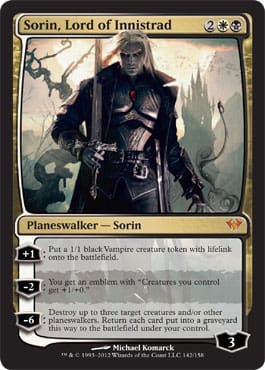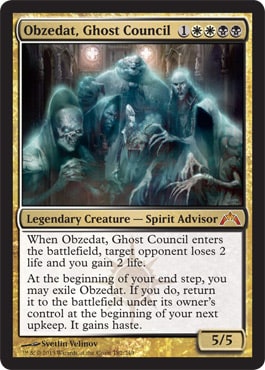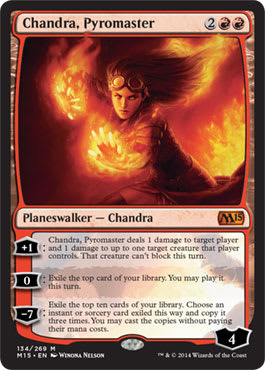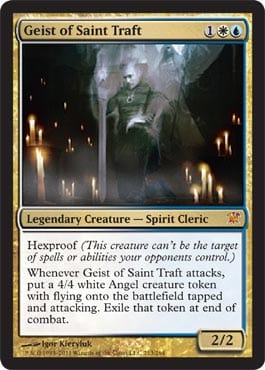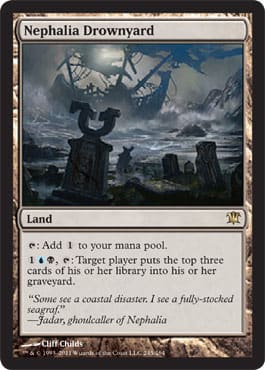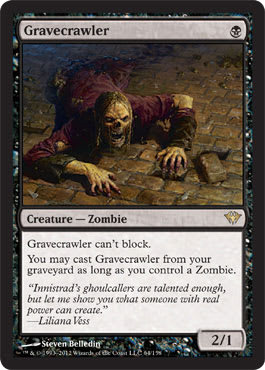The Standard environment is relatively diverse at the moment, but all of the top decks have two important things in common: powerful synergy and the use of cards that are seriously overpowered. By examining how each of these decks goes about doing each of these two things, we can form a better idea of how to construct our own tier-one decks.
"Junk Aristocrats by Charles Johnson"
- Creatures (25)
- 2 Scavenging Ooze
- 3 Desecration Demon
- 4 Blood Artist
- 4 Cartel Aristocrat
- 4 Doomed Traveler
- 4 Voice of Resurgence
- 2 Obzedat, Ghost Council
- 2 Varolz, the Scar-Striped
- Planeswalkers (2)
- 2 Sorin, Lord of Innistrad
- Spells (8)
- 4 Tragic Slip
- 4 Lingering Souls
- Lands (25)
- 1 Swamp
- 2 Gavony Township
- 2 Sunpetal Grove
- 4 Godless Shrine
- 4 Isolated Chapel
- 4 Overgrown Tomb
- 4 Temple Garden
- 4 Woodland Cemetery
The Synergy
This deck is one big engine—an engine that produces creatures, sacrifices creatures to good effect, and then makes use of those creatures again in the graveyard. Not only does the deck contain a healthy twenty-five creatures, it can produce a bunch more with Sorin, Lord of Innistrad and Lingering Souls. Falkenrath Aristocrat, Varolz, the Scar-Striped, and Desecration Demon give you a lot of ways to sacrifice your creatures. Doomed Traveler and Voice of Resurgence replace themselves with tokens, giving you even more creatures to sacrifice. Blood Artist, Tragic Slip, and—to a lesser extent—Aristocrat, Demon, and Varolz benefit immediately from the sacrifices. Once there are creatures in your graveyard, Scavenging Ooze and Varolz make you happy all over again. If, for some reason, you have a bunch of creatures and no way to sacrifice them, Gavony Township, Voice, and Sorin can make your swarm threatening enough to win the game anyway.
The Power Cards
Here, they are Obzedat, Ghost Council, Varolz, and Sorin. Like most legends, these cards are all overpowered compared to most cards at their costs, and their legendary statuses exist at least in part to ameliorate this. Planeswalkers like Sorin are pretty much overpowered as an entire card type due to how they function: They’re hard to destroy, usable right away without going away, reusable, and flexible, and they even typically includes a nuclear option that practically wins the game. The fact that Sorin also happens to go well with this deck’s goals only makes it sicker. Varolz is a 2/2 for 3, which sounds okay, right? What if you could use it as a free sacrifice outlet for your creatures? What if you could regenerate it without paying any mana? Oh yeah, did I mention what it can do with creatures that are in your graveyard? You get an idea of the power level of Obzedat because it found its way into this tightly-synergized deck without really having an important role in the deck’s engine. You play Obzedat because you’re playing a deck that can cast it. It’s a 5/5 for 5 (and not green either!), it can’t be killed by sorceries, and it constantly drains your opponent for 2 life at a time. It’s pretty hard to top that for 5 mana . . . All this, and I haven’t even mentioned Lingering Souls, a serious candidate for one of the Power Nine in Standard.
Any time you can fit this many overpowered cards in a deck with such tight and powerful synergy, good things are bound to result.
"Big Red by Joseph Herrera"
- Creatures (18)
- 3 Hellrider
- 3 Thundermaw Hellkite
- 4 Ash Zealot
- 4 Boros Reckoner
- 4 Chandra's Phoenix
- Planeswalkers (2)
- 2 Chandra, Pyromaster
- Spells (15)
- 3 Brimstone Volley
- 4 Searing Spear
- 4 Pillar of Flame
- 4 Burning Earth
The Synergy
Like most good decks, this one is very focused. In this case, it’s focused on killing the opponent and any creatures that get in the way. While it doesn’t have the kind of tight, synergistic engine of a deck like The Aristocrats, it does make use of synergy. The deck runs Chandra's Phoenix with eleven ways to retrieve it. Hellrider is surrounded by a cast of hardy creatures, many of which have haste, helping power up the Hellrider’s ability. Chandra, Pyromaster helps clear the path for your creatures while building up to a nuclear option that goes with the burn in the deck. Brimstone Volley combines nicely with the massive creature pressure the deck brings to bear. Not only is your opponent pretty much forced to trigger the morbid ability, but the 5 damage will often be a game-ender in this deck.
The Power Cards
This deck’s power cards are Chandra and all of the creatures in the deck. As mentioned above, anytime you can find a planeswalker that fits what your deck is trying to do, it’s overpowered. What makes this deck really powerful is the incredibly high power level of all the creatures. Ash Zealot is a first striking, hasty 2/2 with a special ability, all for only 2 mana. Boros Reckoner is a large, first striking, 3-drop that punishes your opponent for killing it or even blocking it. I discussed the power of Chandra's Phoenix at length.
Hellrider and Thundermaw Hellkite have more in common than originating from the underworld. Both are large for haste creatures at their costs. Hellrider is cheaper and has a sicker special ability, but Hellkite is larger and harder to block.
"Gruul Midrange by Kouichi Kudo"
- Creatures (29)
- 2 Elvish Mystic
- 3 Scavenging Ooze
- 4 Arbor Elf
- 4 Flinthoof Boar
- 4 Ghor-Clan Rampager
- 4 Hellrider
- 4 Strangleroot Geist
- 4 Thundermaw Hellkite
- Planeswalkers (4)
- 4 Domri Rade
- Spells (3)
- 3 Mizzium Mortars
- Lands (24)
- 10 Forest
- 6 Mountain
- 4 Rootbound Crag
- 4 Stomping Ground
The Synergy
The synergy of this deck is very simplistic, but it’s still synergy. By containing good creatures—often with haste—at every point in the curve starting at 1, the deck is able to start putting on pressure immediately and quickly ramp it up. Since the deck has a whopping twenty-nine creatures, not only is Hellrider really happy, but Domri Rade will hit about half of the time when you use the +1 ability. The deck also has a lot of big creatures that go well with Rade’s fighting ability. In addition, the design of the deck creates so much creature pressure that it’s hard for opponents to set up blocks that won’t be completely blown up by using a Ghor-Clan Rampager from your hand.
The Power Cards
The deck gains its extreme power the same way as the Big Red deck above: aggressive creatures that are overpowered for their costs and a planeswalker that fits what the deck’s trying to do.
"Bant Auras by Raymond Tan"
- Creatures (18)
- 3 Avacyn's Pilgrim
- 3 Fiendslayer Paladin
- 4 Gladecover Scout
- 4 Invisible Stalker
- 4 Geist of Saint Traft
- Planeswalkers (1)
- 1 Ajani, Caller of the Pride
- Spells (19)
- 3 Simic Charm
- 4 Ethereal Armor
- 4 Rancor
- 4 Spectral Flight
- 4 Unflinching Courage
- Lands (22)
- 1 Cavern of Souls
- 2 Hinterland Harbor
- 3 Glacial Fortress
- 4 Breeding Pool
- 4 Hallowed Fountain
- 4 Sunpetal Grove
- 4 Temple Garden
The Synergy
The entire concept for this deck is a single synergy concept: putting Auras on creatures that are almost impossible to kill. Putting cards like Spectral Flight and Unflinching Courage on the right hexproof creature can often win the game singlehandedly. Suddenly, you have a super creature that can’t be targeted by your opponent’s removal, and that will kill the opponent faster than he or she can possibly kill you.
The Power Cards
Geist of Saint Traft and Unflinching Courage are this deck’s power cards. While some decks rely heavier on playing with a host of the format’s most powerful cards than on tight synergy or a powerful engine, this deck is clearly more about the sum of its parts rather than any of the individual parts. On their own, neither Geist nor Courage is the caliber of card to rock a Standard environment, but they are clearly the two cards that make this deck really special. Imagine going first and playing a turn-two Geist of Saint Traft after a first-turn Elf. This already poses a major threat because it can’t be removed and it represents 6 damage a turn. Ordinarily, most decks would just answer by playing a good blocker, but put an Unflinching Courage on it, and it’s suddenly too big to block in the early game, and it’s hitting for 8 and gaining 4, burying your opponent in a huge hole in the process. By the time your opponent has enough power on the board to properly block it, you’ve added another enchantment to the Geist, and it’s down to just the running and the screaming.
"Esper Control by Ken Kiley"
- Creatures (6)
- 3 Augur of Bolas
- 3 Restoration Angel
- Planeswalkers (3)
- 1 Jace, Memory Adept
- 2 Tamiyo, the Moon Sage
- Spells (26)
- 1 Forbidden Alchemy
- 2 Doom Blade
- 3 Dissipate
- 3 Syncopate
- 3 Think Twice
- 4 Azorius Charm
- 4 Sphinx's Revelation
- 4 Supreme Verdict
- 2 Detention Sphere
- Lands (25)
- 1 Island
- 1 Plains
- 1 Ghost Quarter
- 1 Isolated Chapel
- 1 Reliquary Tower
- 2 Godless Shrine
- 3 Nephalia Drownyard
- 3 Watery Grave
- 4 Drowned Catacomb
- 4 Glacial Fortress
- 4 Hallowed Fountain
The Synergy
There are so many angles of synergy that this deck is working on that you might think it would actually hurt the deck’s overall synergy, but it all seems to work out just fine:
- Augur of Bolas with instants and sorceries
- Augur of Bolas with Restoration Angel
- Nephalia Drownyard with flashback spells
- Nephalia Drownyard with Jace, Memory Adept
- Supreme Verdict with Sphinx's Revelation
- Supreme Verdict with Tamiyo, the Moon Sage
You get the idea. Everything is in this deck for a reason and usually works nicely with multiple other things in the deck.
The Power Cards
Supreme Verdict, Sphinx's Revelation, and Restoration Angel are this deck’s power cards. Revelation and Restoration Angel are card-carrying members of the new Power Nine, and in the current environment, Verdict probably should be, too. As the many decks running twenty or more aggressive creatures load up the board with pressure, it’s nice to be able to nuke everything with one card and not worry about having it countered. It gives you an idea of how much power this deck plays with that it has two different planeswalkers with neither among the three most powerful cards in the deck.
"Jund Midrange by Dan Musser"
- Creatures (14)
- 3 Scavenging Ooze
- 4 Huntmaster of the Fells
- 4 Thragtusk
- 3 Olivia Voldaren
- Planeswalkers (2)
- 2 Garruk, Primal Hunter
- Spells (19)
- 1 Abrupt Decay
- 1 Doom Blade
- 2 Putrefy
- 2 Tragic Slip
- 1 Dreadbore
- 1 Mizzium Mortars
- 2 Rakdos's Return
- 4 Bonfire of the Damned
- 4 Farseek
- 1 Rakdos Keyrune
- Lands (25)
- 1 Dragonskull Summit
- 2 Cavern of Souls
- 2 Kessig Wolf Run
- 4 Blood Crypt
- 4 Overgrown Tomb
- 4 Rootbound Crag
- 4 Stomping Ground
- 4 Woodland Cemetery
The Synergy
Of all of the popular decks in the format, this is the one that probably relies the least on tight synergy. This is basically a three-colored good-stuff deck featuring a sampling of the best creatures and removal the format has to offer. Probably the most important synergy in the deck is between the mana-ramping of Farseek and Rakdos Keyrune and expensive cards such as Rakdos's Return and Bonfire of the Damned.
The Power Cards
Given the nature of the deck, almost every card in it is incredibly powerful. Farseek, Huntmaster of the Fells, and Thragtusk are part of the Power Nine, and the deck features several other cards on the high end of the power scale: Rakdos's Return, Bonfire, Garruk, Primal Hunter, and Olivia Voldaren. Farseek makes the colors and the curve of the deck work, and the rest of the cards generate massive card advantage while helping you take over the game.
"Golgari Control by munkeemanometal (MTGO)"
- Creatures (29)
- 2 Disciple of Bolas
- 2 Lifebane Zombie
- 3 Dreg Mangler
- 3 Knight of Infamy
- 3 Scavenging Ooze
- 4 Desecration Demon
- 4 Geralf's Messenger
- 4 Gravecrawler
- 4 Lotleth Troll
- Spells (8)
- 2 Abrupt Decay
- 3 Putrefy
- 3 Tragic Slip
- Lands (23)
- 7 Swamp
- 2 Golgari Guildgate
- 2 Mutavault
- 4 Cavern of Souls
- 4 Overgrown Tomb
- 4 Woodland Cemetery
The Synergy
This deck uses all sorts of creature synergy: Gravecrawler combines with Lotleth Troll, Desecration Demon, Disciple of Bolas, and the many Zombies in the deck. Lotleth Troll, Disciple of Bolas, Desecration Demon, and your removal help feed Scavenging Ooze. Your sacrifice outlets Demon and Disciple go with Geralf's Messenger and Tragic Slip.
The Power Cards
Lotleth Troll is the most obviously busted card in the deck, but Gravecrawler may be the best 1-drop in Standard, all things considered. 2/1s for 2 are pretty common in Magic. A 2/1 for 2 that regenerates for 1 mana is excellent; add in trample, and the Troll’s pitch ability, and the only reason it wasn’t in the Power Nine was that it wasn’t being played in enough decks.
These decks may vary from relying mainly on synergy—such as Bant Auras—to relying mainly on playing with boatloads of busted cards—such as Jund Midrange—but it’s clear that these are both qualities to be seeking when designing a deck. Your deck should feature many overpowered cards that fit neatly into synergies that make them and the deck even more powerful. After all, if you’re building “fair” decks, expect to be a fair distance from the Top 8 at the end of the day.
On another note, some of you may wonder what I do with my time besides play Magic and write about Magic. Well, here’s what I’ve been working on: http://starrealms.com/. I’ve designed a new card game called Star Realms that combines the fun of a deck-building game with the interactivity of TCG-style combat. This empire-building, space-combat game will be released as both a physical card game and as a multi-platform digital game.
The physical game is scheduled to hit stores by December of this year. Stay tuned to this space for details of our upcoming Kickstarter campaign and your chance to help make the game a reality and to pick up exclusive Kickstarter rewards. GatheringMagic was at Gen Con, where we talked to Star Realms developer and Magic Hall of Famer Rob Dougherty, who explained what Star Realms is all about.













